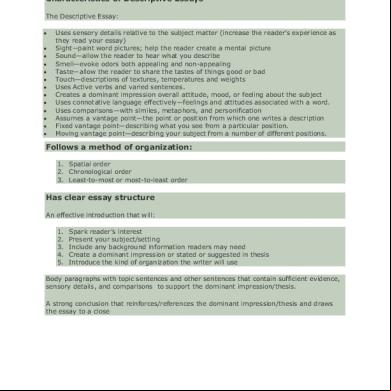Characteristics Of Descriptive Essays 2ws2j
This document was ed by and they confirmed that they have the permission to share it. If you are author or own the copyright of this book, please report to us by using this report form. Report 2z6p3t
Overview 5o1f4z
& View Characteristics Of Descriptive Essays as PDF for free.
More details 6z3438
- Words: 246
- Pages: 1
c The Descriptive Essay: V V V V V V V V V V V V V
ñses sensory details relative to the subject matter (increase the reader¶s experience as they read your essay) ight--paint word pictures; help the reader create a mental picture ound²allow the reader to hear what you describe mell²evoke odors both appealing and non-appealing Taste²allow the reader to share the tastes of things good or bad Touch²descriptions of textures, temperatures and weights ñses Active verbs and varied sentences. creates a dominant impression overall attitude, mood, or feeling about the subject ñses connotative language effectively²feelings and attitudes associated with a word. ñses comparisons²with similes, metaphors, and personification Assumes a vantage point²the point or position from which one writes a description ëixed vantage point²describing what you see from a particular position. oving vantage point²describing your subject from a number of different positions.
ë 1.V patial order 2.V chronological order 3.V Least-to-most or most-to-least order
ΠAn effective introduction that will: 1.V 2.V 3.V 4.V 5.V
park reader¶s interest Present your subject/setting Include any background information readers may need create a dominant impression or stated or suggested in thesis Introduce the kind of organization the writer will use
Body paragraphs with topic sentences and other sentences that contain sufficient evidence, sensory details, and comparisons to the dominant impression/thesis. A strong conclusion that reinforces/references the dominant impression/thesis and draws the essay to a close
V
ñses sensory details relative to the subject matter (increase the reader¶s experience as they read your essay) ight--paint word pictures; help the reader create a mental picture ound²allow the reader to hear what you describe mell²evoke odors both appealing and non-appealing Taste²allow the reader to share the tastes of things good or bad Touch²descriptions of textures, temperatures and weights ñses Active verbs and varied sentences. creates a dominant impression overall attitude, mood, or feeling about the subject ñses connotative language effectively²feelings and attitudes associated with a word. ñses comparisons²with similes, metaphors, and personification Assumes a vantage point²the point or position from which one writes a description ëixed vantage point²describing what you see from a particular position. oving vantage point²describing your subject from a number of different positions.
ë 1.V patial order 2.V chronological order 3.V Least-to-most or most-to-least order
ΠAn effective introduction that will: 1.V 2.V 3.V 4.V 5.V
park reader¶s interest Present your subject/setting Include any background information readers may need create a dominant impression or stated or suggested in thesis Introduce the kind of organization the writer will use
Body paragraphs with topic sentences and other sentences that contain sufficient evidence, sensory details, and comparisons to the dominant impression/thesis. A strong conclusion that reinforces/references the dominant impression/thesis and draws the essay to a close
V





